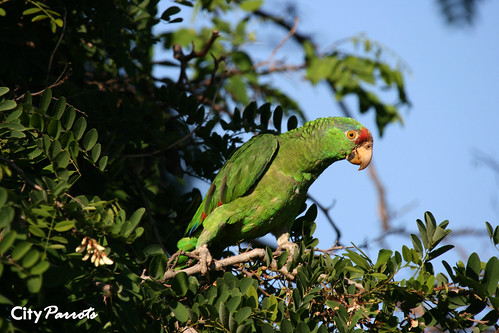 Red-crowned amazon (Amazona viridigenalis) in Orange County, CAJust as the blazing afternoon sun softens and begins to set, the parrots start to arrive, squawking and keening as they wheel high overhead in the blue sky and drop into the upper fronds of palm trees growing along the Rio Grande.
Red-crowned amazon (Amazona viridigenalis) in Orange County, CAJust as the blazing afternoon sun softens and begins to set, the parrots start to arrive, squawking and keening as they wheel high overhead in the blue sky and drop into the upper fronds of palm trees growing along the Rio Grande.
''They do that every night,'' says Jessie Moreno, a cashier at the Fort Brown Hotel, who likes to watch the birds roosting on the hotel grounds. ''They come swooping back here when it starts to get dark and spend the night up in those palm trees. In the morning they'll take off again and fly out over the city looking for food.''
The birds call to each other as they dart from tree to tree, brightly colored slashes of green, yellow and blue, and when a truck backfires nearby they howl and take to the air as one, screaming wildly as they swirl overhead.
''Don't worry,'' Ms. Moreno says, ''they'll be back.''
But the parrots, more than 300 of a species known scientifically as Amazona viridigenalis, are not really supposed to be here in the first place.
Wild parrots in an urban environment like this dusty, bustling border city seem unusual enough, but this flock is also odd for other reasons, local experts say.
They are at least a hundred miles from their typical roosting grounds deep in Mexico, and a third of the parrots are birds released by or escaped from smugglers trying to slip them illegally into the country, said Steve Walker, a staff member at the University of Texas at Brownsville who leads birding tours as part of the university's adult education programs.
Mr. Walker said a devastating freeze in 1982, coinciding with an agrarian overhaul that deforested large sections of northern Mexico, combined to draw a majority of the birds into the Brownsville area.
''After that freeze we started seeing large numbers of free-range parrots here,'' Mr. Walker said. ''Our conjecture is that a flock of old veterans, who had made the trip before, decided to come up out of Mexico into this area to forage. These birds can live to be 60 to 70 years old, and sometimes longer than that.''
There is anecdotal evidence from old military diaries, Mr. Walker said, of sightings of parrots even farther north, along the Nueces River area, at a time when Gen. Zachary Taylor's troops were quartered there in the Mexican War in 1847.
''That was in November, in the pecan season, and these parrots just love pecans,'' he said. ''So they must have flown at least 200 miles even further north to look for them.''![]()